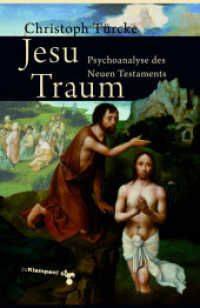- ホーム
- > 洋書
- > ドイツ書
- > Humanities, Arts & Music
- > Religion & Theology
Full Description
Origins of Eastern Christian Mysticism asserts that the thinkers between Basil of Caesarea and Symeon the New Theologian were important mainly for their role in the formation of Hesychasm, a fourteenth-century mystical movement in the Eastern church. The book surveys previous research on Proto-Hesychasm and sets forth eight Hesychastic trends in its practitioners: monasticism, dark and light mysticism, and an emphasis on the heart, theōsis, the humanity of Christ, penthos, and unceasing prayer.
Theodore Sabo integrates detailed and carefully researched accounts of the lives and thought of the foundational figures of Hesychasm into a compelling narrative of the movement's origins. The Cappadocian fathers established monasticism as the predominant milieu of Proto-Hesychasm and emphasized both theōsis and dark mysticism. Dark mysticism would come into conflict with the light mysticism of their contemporary Pseudo-Macarius, but both currents would be passed on to the Hesychasts. Macarius was a seminal figure within Proto-Hesychasm, responsible for its stress on light mysticism and heart mysticism. Hesychasm itself, the author contends, emerged from two main Proto-Hesychast fonts, the philosophical (represented by such figures as Pseudo-Dionysius and Maximus the Confessor) and the ascetic (the realm of figures like John Climacus and Isaac of Nineveh). The former school transmitted to Hesychasm a virtually unacknowledged Platonism; the latter contributed to Hesychasm's preoccupation with theōsis, penthos, and unceasing prayer, albeit from a solely monastic perspective. Finally, Symeon the New Theologian emerged as the redoubtable successor to these schools, unifying their distinct traditions in his philosophical approach.
While previous scholarship has documented the connections between Proto-Hesychasm and Hesychasm, Origins of Eastern Christian Mysticism is unique in its treatment of the Proto-Hesychasts as a distinguishable group, and as direct instigators of Hesychasm. This provocative study should be of interest to students and scholars of the late antique history of the Eastern Orthodox Church, as well as to contemporary theologians steeped in the Eastern mystical tradition.
Contents
Preface - Introduction - The Hesychasts: Beginning at the End - Basil the Great - Gregory of Nazianzus - Gregory of Nyssa: The Divine Darkness - Pseudo-Macarius: Towards the Hesychastic Light - Macarius' Epigones - Dionysius the Pseudo-Areopagite - Maximus the Confessor - Isaiah of Scetis - The School of Gaza - John Climacus - Isaac of Nineveh - The Circle of John Climacus - Symeon the New Theologian - Symeon's Circle - Conclusion - Chronology - Glossary of Semitic Words.







